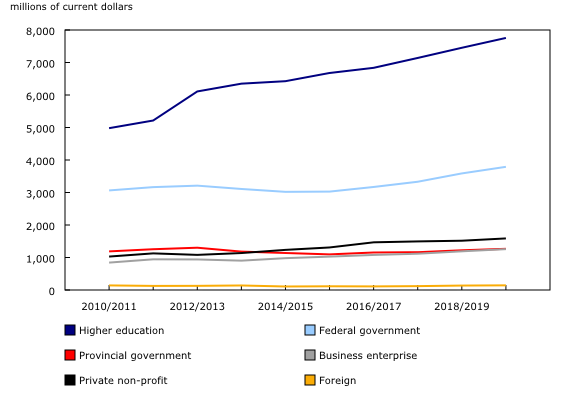Spending on research and development in the higher education sector, 2019/2020
Archived Content
Information identified as archived is provided for reference, research or recordkeeping purposes. It is not subject to the Government of Canada Web Standards and has not been altered or updated since it was archived. Please "contact us" to request a format other than those available.
Released: 2022-01-07
Research and development (R&D) expenditures in the higher education sector in Canada increased 4.6% from 2018/2019 to $15.8 billion in 2019/2020. This was the 10th consecutive annual gain.
Innovations generated by R&D activities contribute to increased productivity and greater economic outputs. The knowledge creation generated by Canada's higher education sector serves as an important input for many sectors of Canada's economy, which directly benefit Canadians.
Research and development spending increases in all funding sectors, but at a slower pace
R&D spending rose across all funding sectors in 2019/2020, though the increase in spending for each sector was less than what occurred in the preceding year. The largest amount of funding for higher education R&D came internally from the higher education sector itself. Their R&D funding increased by $303.0 million (+4.1%), a small decline from the $312.4 million increase that occurred in 2018/2019 (+4.4%). The federal government sector, the next largest funder of higher education R&D, experienced a similar change, with spending rising by $202.7 million in 2019/2020 (+5.7%), which is down slightly from the $255.7 million increase realized in 2018/2019 (+7.7%).
Research and development spending up across both fields of science
Funding increased across most funding sectors for both the natural sciences and engineering, and the social sciences and humanities fields. Expenditures in the field of natural sciences and engineering, the larger of the two fields by a 3-to-1 margin, rose to $11.9 billion from $11.4 billion in 2018/2019 (+4.4%). Expenditures in the field of social sciences and humanities rose to $3.9 billion from $3.7 billion (+5.3%).
Provincial research and development spending varied
The highest proportion of overall higher education R&D expenditures in 2019/2020 came from Ontario (39.7%), followed by Quebec (25.4%), British Columbia (12.0%) and Alberta (10.7%). Among the provinces, British Columbia saw the greatest increase; its R&D expenditures were up 7.1% to $1.9 billion, which was driven by increased expenditures in the social sciences (+9.6%). The largest decrease in R&D expenditures occurred in New Brunswick (-2.7% to $198 million), as a result of a 5.0% decrease in expenditures in the natural sciences.
Canada continues to be a world leader in higher education spending
An R&D intensity indicator, such as R&D expenditures as a ratio of nominal gross domestic product at market prices, provides a lens through which the sector's impact can be measured. In 2019, Canada had the highest education R&D intensity (0.68) among the G7 countries. Canada also ranked sixth in R&D intensity among member nations of the Organisation for Economic Co-operation and Development (OECD) and has consistently ranked among the top since the creation of the Canada Research Chairs program in the 1990s.
Note to readers
Concepts for expenditures on research and development in the higher education sector
The higher education sector is composed of all universities, colleges of technology and other institutions that provide formal tertiary education programs, as well as all research institutes and centres, experimental stations, and clinics that are operated under the direct control of higher education institutions.
Higher education research and development (HERD) is a large component of Canada's overall gross expenditures on research and development (R&D). Science and technology (S&T) activities conducted by higher education institutions produce knowledge that seeds innovations in the other performing sectors of the economy. Moreover, HERD spending increases the capacity of S&T activities that researchers are able to perform in all sectors of the Canadian economy.
Total expenditures on research and development (R&D) are classified into two fields of science: natural sciences and engineering; and social sciences, humanities and the arts.
There are six funding sources for R&D expenditures in the higher education sector: business enterprises, private non-profit organizations, the federal government, provincial governments, the foreign sector and internal funding from the higher education sector.
The R&D intensity of a country is the ratio of R&D expenditures to gross domestic product (GDP). This can also be calculated for the sectors of a country's economy. This indicator facilitates comparisons both over time and between countries.
With the release of data for the reference period 2019/2020, previously released data from 2010/2011 to 2018/2019 have been revised.
For further information on concepts and definitions relating to R&D expenditures in the higher education sector, please see this release's "Related information" tab.
References
OECD. (2015). Frascati Manual 2015: Guidelines for Collecting and Reporting Data on Research and Experimental Development, The Measurement of Scientific, Technological and Innovation Activities, OECD Publishing, Paris.
OECD Science, Technology and Innovation Scoreboard. (2021). On this page, search for ''HERD as a percentage of GDP'' under ''Gross Domestic expenditures on R&D by performing sector''.
Contact information
For more information, or to enquire about the concepts, methods or data quality of this release, contact us (toll-free 1-800-263-1136; 514-283-8300; STATCAN.infostats-infostats.STATCAN@canada.ca) or Media Relations (613-951-4636; STATCAN.mediahotline-ligneinfomedias.STATCAN@canada.ca).
- Date modified:



